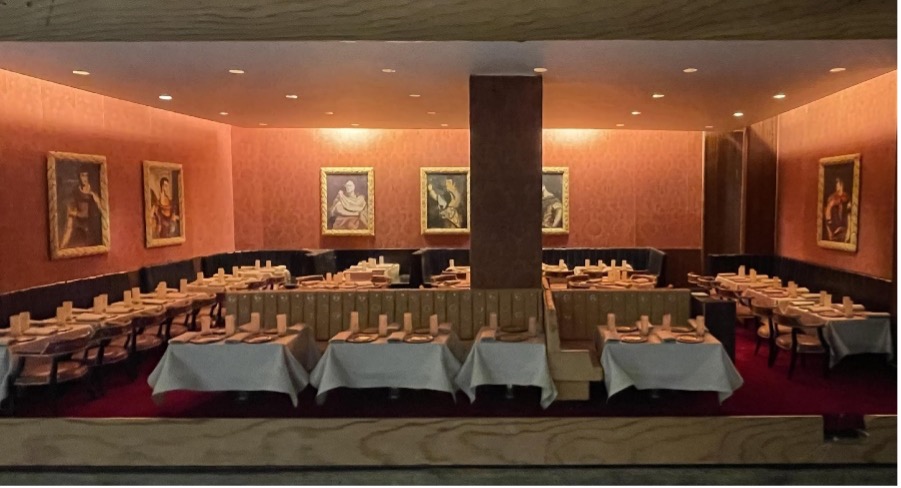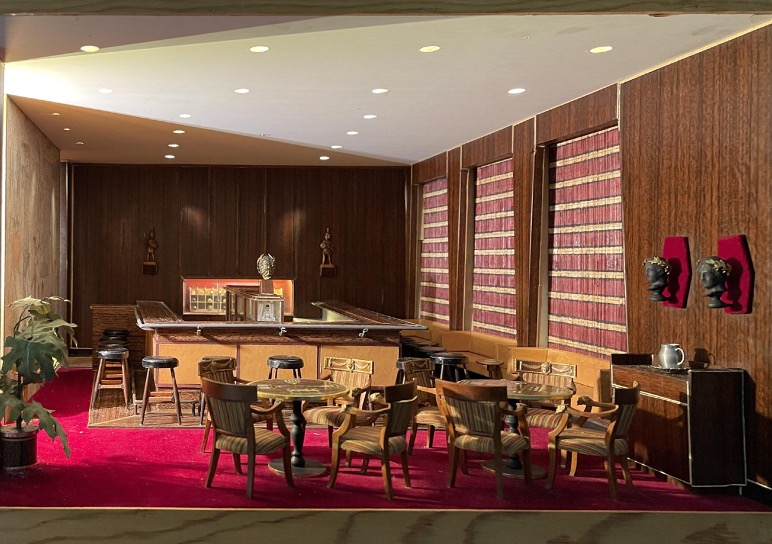When conserving an object there are an almost limitless number of goals you might have in mind. You might be prioritizing structural integrity, repair, or even aesthetics, but is it possible to work towards something more? Can someone capture the essence of a work and bring it back to life?

This is a thought I had while working on The Forum of the Twelve Caesars (1957). The object is large and crate-like and, while unassuming at first glance, it hides a beautiful interior.
Inside lies a 12:1 scale model of a restaurant and bar, complete with cups, carpeting, and a mural. When I first began work on the model, it also had the unwelcome additions of broken glass, dust, and grime coating every surface. I would later realize that the physical clean-up was the easy part. Even after some desperately needed surface cleaning, filling, and in-painting, something was missing. But what could it be? The model was clean, losses were minimized, and it was in overall great shape. As I would find out later, the missing piece was light, or more literally, the actual lighting components that needed treatment.
 These two lighting components are composed of large sheets of galvanized steel held in a wooden frame, much like a box lid with wooden sides and a metal top. The galvanized steel had severe “white rust” corrosion coating both sides which created a film of white dust that was easily disturbed. Before placing the two pieces on top of the model, Hagley’s Objects Conservator, Ebenezer Kotei, advised us to clean and coat the metal (see video below). We did this by brushing and vacuuming the pieces, wiping them down with mineral spirits, and applying a transparent and colorless coating of Thermoplastic Acrylic resin called Paraloid B-48N. By agitating and vacuuming the surface metal, we removed a significant amount of excess corrosion. The mineral spirits helped ensure the metal was doubly clean. Initially B-48 is solid, so the resin was first dissolved in acetone to create a 10% solid saturated solution and was then applied using a brush. This coating will prevent future corrosion and is resistant to any heat that the lighting elements may generate.
These two lighting components are composed of large sheets of galvanized steel held in a wooden frame, much like a box lid with wooden sides and a metal top. The galvanized steel had severe “white rust” corrosion coating both sides which created a film of white dust that was easily disturbed. Before placing the two pieces on top of the model, Hagley’s Objects Conservator, Ebenezer Kotei, advised us to clean and coat the metal (see video below). We did this by brushing and vacuuming the pieces, wiping them down with mineral spirits, and applying a transparent and colorless coating of Thermoplastic Acrylic resin called Paraloid B-48N. By agitating and vacuuming the surface metal, we removed a significant amount of excess corrosion. The mineral spirits helped ensure the metal was doubly clean. Initially B-48 is solid, so the resin was first dissolved in acetone to create a 10% solid saturated solution and was then applied using a brush. This coating will prevent future corrosion and is resistant to any heat that the lighting elements may generate.
In addition to the coating, Hagley’s Electrician, Brian Jones, worked with us to get the lighting components in working order. This is where the more non-physical aspects of conservation come into play. How was this model meant to be lit, and how can we strike a balance between visual accuracy and object stability?
 This model was produced in the late 1950s, when heat-producing incandescent lighting was prominent. These bulbs were ruled out almost immediately due to the dangers of heat being housed within the object. We also thought of using dimmable lighting which would help customize the light levels and minimize UV damage should the object ever go on display. Luckily, and with multiple trips to the store, Brian was able to select some LED lightbulbs in distinct colors and wattages for us to test out.
This model was produced in the late 1950s, when heat-producing incandescent lighting was prominent. These bulbs were ruled out almost immediately due to the dangers of heat being housed within the object. We also thought of using dimmable lighting which would help customize the light levels and minimize UV damage should the object ever go on display. Luckily, and with multiple trips to the store, Brian was able to select some LED lightbulbs in distinct colors and wattages for us to test out.
We tested boxes of lightbulbs; some were too cool, too bright, or too big, but eventually we struck gold. This is when the model truly came to life. Warm lights in a mix of different wattages washed over the interior, creating beautifully intentional splashes of light. Something about seeing the light inside the object completed it more than any other bit of work I had done. No amount of in-painting or vacuuming could reproduce the level of emotion that the light achieved. The alluring warmth and beautiful intentionality in each shadow and shimmer is what makes The Forum of the Twelve Caesars.

In exploring the lighting of this model, I was able to see the “soul” of the object. I was able to experience what makes some things so special. Sometimes these ethereal aspects, these non-physical, and unprioritized, parts are what truly bring precious objects to life. Conserving light in a literal sense is probably impossible, but conserving the light, what makes a painting emotional, what makes a book worth reading, I think, in many cases, is more than possible. Every meaningful object, in a museum, archive, or otherwise, has a light, something intrinsic. In this particular case I was able discover that quality in Pahlmann and Kupjack’s work by truly conserving light.
Leilani Anupol is the Library Conservation Intern at Hagley Museum and Library. They are enrolled in the undergraduate Art Conservation program at the University of Delaware, minoring in Museum Studies and Chemistry.
